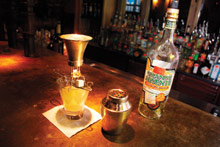Absinthe is one of the most mythologized of all liquors. Depending on which legends you believe, it either rots the brain or is a magic key to artistic genius.

First distilled from anise, fennel and wormwood (among other herbs) in the 1700s, this extremely high-proof drink took the world by storm in the 19th century, becoming immensely popular—especially as the signature drink for artists, writers and just plain-out party people.
Unfortunately, prohibitionist prudery and inflated tales of its nefarious effects led to real absinthe’s being essentially banned from the United States in 1912. Fortunately, in 2007 the ban was finally lifted, and absinthe began to make a slow-but-steady return.
However, in North Carolina—thanks to the state-run liquor monopoly—absinthe has to be specially ordered by the case. In their pursuit of unique and classical drinks, however, downtown spot Zambra has it.
Admittedly, at $15 a pop it’s expensive, but this is a very rare taste these days, and Zambra has gone to exquisite care in the preparation—a ritual almost as famous as absinthe itself.
Absinthe, you see, is not consumed straight. In the most common method, ice-cold water is carefully poured over sugar placed on a specially designed spoon, creating a cloudy effect known as the louche.
Some, however, go the extra mile, and Zambra’s bartenders use a balancier—a funnel-like device that attaches to the edge of the glass and measures out the water drop by drop—to get the smoothest taste possible.
That taste itself is extremely rich and varied, with a very slight resemblance to licorice. Despite the sugar, it’s not too sweet: a welcome relief from the often overly sugary concoctions that dominate too many bars these days.
In addition, thanks to the herbal components, it gives a nicely lucid buzz. You (probably) won’t see green fairies, but it still inspires.
To watch a video of the making of the drink, click below.



Just give me that old whiskey, barkeep.